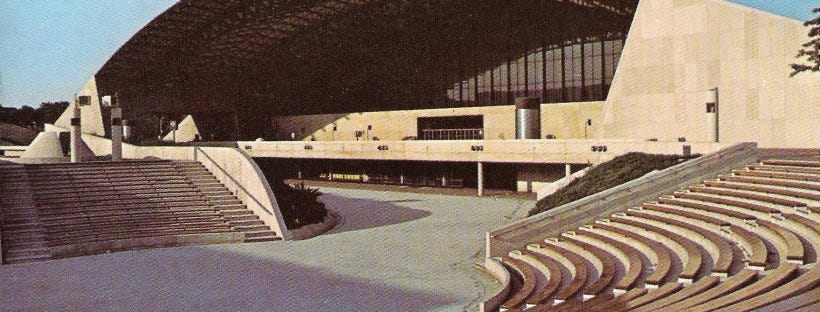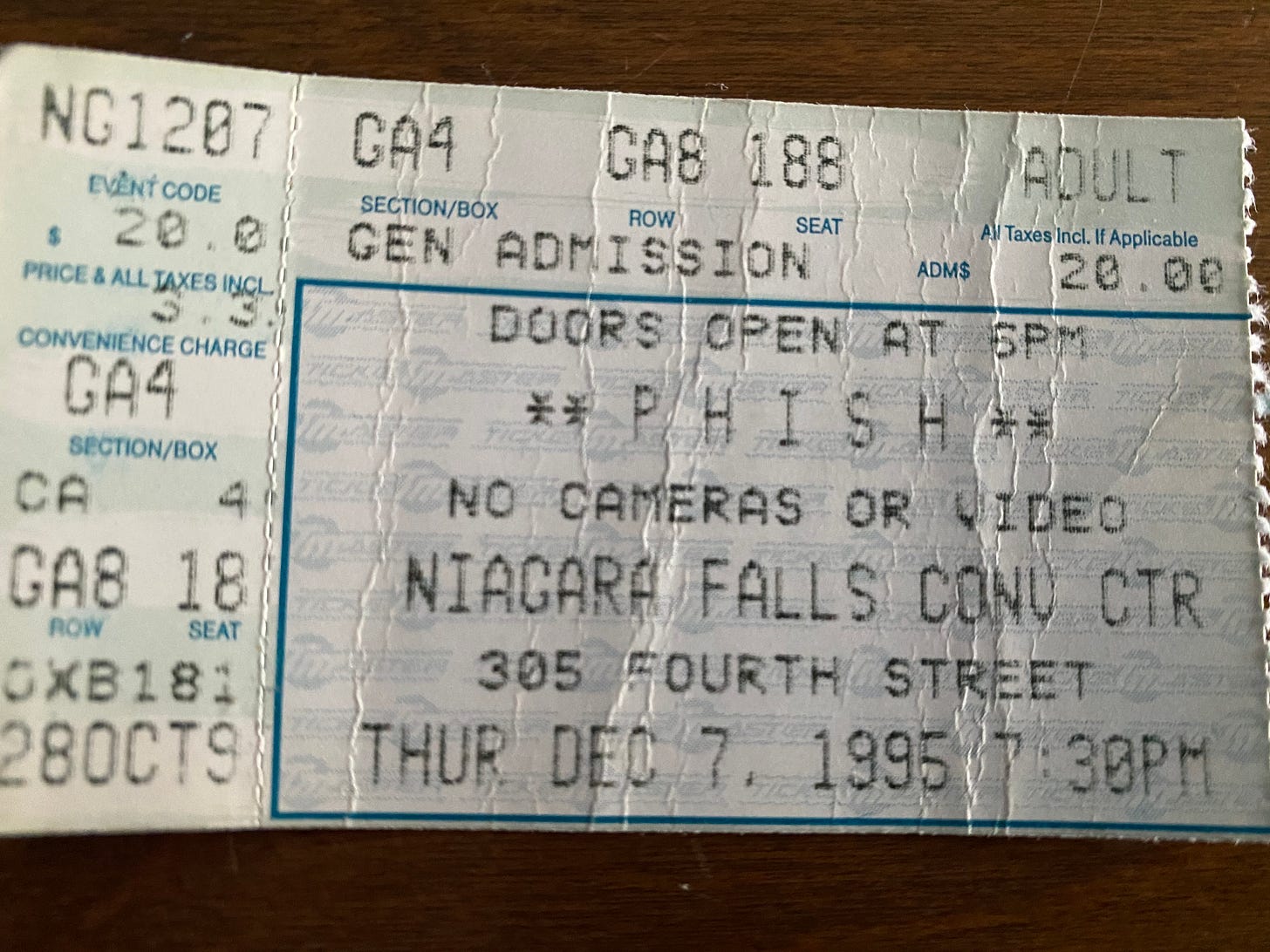Rolling Thunder
12/7/95, Niagara Falls Convention Center, Niagara Falls, NY
SET 1: The Old Home Place > The Curtain > AC/DC Bag, Demand > Rift, Slave to the Traffic Light, Guyute, Bouncing Around the Room, Possum, Hello My Baby
SET 2: Split Open and Melt, Strange Design > Taste That Surrounds, Reba, Julius, Sleeping Monkey > Sparkle > Mike's Song -> Weekapaug Groove -> Digital Delay Loop Jam, Amazing Grace
ENCORE: Uncle Pen
"The Niagara Falls concert showed precisely the difficulties in taking a personal and essentially low-key art to a mass audience. The size of the crowd, poor acoustics and poor seating arrangements prevented intimacy. An easily excited crowd surged constantly around the hall, interrupting even quiet music with cheers, calls, and whistling." - Eric Mills, Winnipeg Free Press
"The [band] wasn't performing for the audience, it was performing for itself and it decided to allow a few bodies the opportunity of observing what uncommercial music is all about.” - Gordon Venner, unknown local newspaper.
Twenty years before Phish’s monumental December 1995 run, another band barnstormed around many of the same New England towns and venues. Or maybe “band” isn’t quite the right word; the Rolling Thunder Revue was a traveling roadshow of musicians in orbit around Bob Dylan, coming and going as their schedules allowed. The two tours shared — two decades apart — the Niagara Falls Convention Center, the Providence Civic Center, the New Haven Veterans Memorial Coliseum, a passage through Worcester (though not the same venue), and a big finale in Madison Square Garden.
If you’ve been following Ray Padgett’s Dylan Live newsletter — which is finishing up a show-by-show run through the Rolling Thunder tour, and from which I pilfered the above review excerpts — you’re getting a deeper account of Rolling Thunder 1975 than last year’s fabulist Martin Scorcese documentary provided. Now it is absolutely coincidence — or at most, a sign of sluggish regional music venue investment in the 70s through 90s — that Rolling Thunder and Phish visited so many of the same New England venues. And the artists at the center of the two tours were in very different places; Phish reaching their first commercial summit, Dylan pulling back after the excesses of his 1974 reunion tour with The Band, playing cities with short notice guerilla-style.
But from different points of origin, both tours find themselves in similar zones, to my ears: the kind of feverish abandon of musicians in the absolute right place and time. Listen or watch Dylan and his crack RTR band Guam play “Isis,” cake makeup sweating off his forehead above crazy eyes, and tell me if you don’t catch some of the same intoxicating spirit as the New Haven Tweezer, even if the songs sound nothing alike. Those two reviews up top also suggest similar pressures on the two groups: large-venue headaches and the high-wire tension between self-indulgence and crowd-pandering that gets only more fraught when the crowd numbers in the five figures.
The Rolling Thunder Niagara Falls stop (they played two shows!) may not have stood out from the rest of the tour; according to Ray, it was the site of the tour’s only “Like A Rolling Stone” and a visit from OJ Simpson, who said of “Hurricane”: “That song is great. I’m gonna tape that bitch.” The Phish stop in Niagara Falls...well, it might be nothing short of the best encapsulation of everything that makes December 95 great. It’s funny that it took until 2013 to get the full-show soundboard treatment, lining up behind 12/14, 12/31, 12/1 for that honor. Because this show, more than any of the above, covers all of the things that make this era of Phish great, in a single set.
That’s not to sell the night’s opening frame short — all by itself, it would qualify tonight as an above-average evening. 45 shows into the tour, everything in the catalog is played at its absolute best: The Curtain, Rift and Guyute are as tight as a drum even at blistering pace, AC/DC Bag and Possum are exemplary arena-rock, Slave is a showstopper only a quarter of the way into the night. It’s Phish casually showing that they’re the best at what they do, and then…
Showing, in the second set, that they can do even better. The Shapiro notes for this show reports, tantalizingly, that “The repeated Including Your Own “Hey” exercises and Run Like An Antelope Jams from the soundcheck were listening exercises focused on adding “more space” into the music and were replete with ‘space is the place’ comments.” Nearly three months into this tour, they’re still revising their sound, and it pays dividends in a set that is deep in improv highlights.
It begins with Melt, which hasn’t often been a highlight in Fall 95, its rhythmic complexities a poor fit with the more direct attacks they’ve been exploring most nights. But this one absolutely feels like it has been hey-holed, all four members of the band maneuvering around each other without stepping on each other’s toes like a tightly choreographed dance ensemble. From the “In a Gadda Da Vida” tease onwards, Trey darts around the jam — not soloing, not playing rhythm guitar, not doing pedal textures or mini-kitting, just adding pointillist stabs that let Mike and Page flourish over Fishman’s firm hand. There’s not a lot of juggling the three-note return between members in this version, it’s mostly just on Fish, but that still leaves him plenty of room to play, moving those three hits all over his kit and filling the rest with the arena-jazz he’s perfected.
There’s a bit of a lull — even this set can’t yet trim the fat entirely — as they ease off for Strange Design and Taste That Surrounds, but the uncommon late reservation for Reba ramps it back up quickly. I’m not going to take a BPM counter to the whole tour, but by the extremely unofficial metric of “my toddler trying to sing along,” each Reba feels faster than the last, and this one almost breaks them; Trey pushes back on the speed of the lyrics. They’re into the jam in less than 5:30, and it's tremendous, the same ballet of delicately interweaving parts but ported over to an entirely different mood than Melt...at least until an unsettling, noisy coda.
After the lethal-dose power-swing of Julius and the set’s second lull comes the set’s third improvisational treasure, and the best of the three: a second run at the blasphemous Mike’s > Weekapaug combo. Whereas Hershey’s direct soldering of the two songs ran on the giddy energy of breaking rules, this one is a monster on its own terms, just two of Phish’s most reliably exploratory songs, back-to-back with no chance to catch your breath or run to the urinals between. Instead, there’s a solid five minutes (from 12:45 of the Mike’s) where they’re simply playing the two songs simultaneously, as if that’s a thing bands just do. I’m not sure how you’d scientifically quantify such a thing, but it must be one of the longest segues in Phish history, if not the longest.
When they finally get to the actual Weekapaug, they remember to modulate this time (at 0:48), and then proceed to cram every improv trick remaining in their inventory into the song’s 13 minutes. There’s a mind-blowing Trey solo, a brief funk jam that accelerates and diminuendos, and then the first proper digital delay loop jam since nearly a year ago in Providence, another deliciously dark surprise ending that balances the jubilation of just a few minutes earlier. It never finds its way back to Weekapaug; they sing Amazing Grace instead, as though trying to ward off the dark energy they themselves created.
Rolling Thunder shows ended with their own hymn-like singalong, though a secular one: This Land Is Your Land. In both cases, they felt like a cleansing, not just from the intensity of the show (in Dylan’s case, fueled by heavy arrangements of his old material and the marital angst of his new) but also the “uncommercial music” on display. Just a short walk away from the awesome, terrible beauty of the falls, both tours captured some of that hydroelectric energy, playing high water mark tours two decades apart.
[Ticket stub from Adam Richards. Also here’s Phish playing “Hurricane” at the midpoint between Rolling Thunder and Fall 95.]



